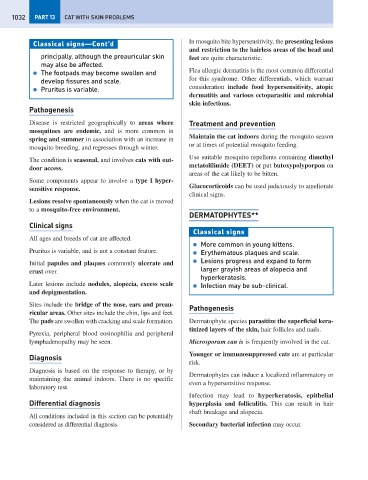Page 1040 - Problem-Based Feline Medicine
P. 1040
1032 PART 13 CAT WITH SKIN PROBLEMS
Classical signs—Cont’d In mosquito bite hypersensitivity, the presenting lesions
and restriction to the hairless areas of the head and
principally, although the preauricular skin feet are quite characteristic.
may also be affected.
● The footpads may become swollen and Flea allergic dermatitis is the most common differential
develop fissures and scale. for this syndrome. Other differentials, which warrant
● Pruritus is variable. consideration include food hypersensitivity, atopic
dermatitis and various ectoparasitic and microbial
skin infections.
Pathogenesis
Disease is restricted geographically to areas where Treatment and prevention
mosquitoes are endemic, and is more common in
Maintain the cat indoors during the mosquito season
spring and summer in association with an increase in
or at times of potential mosquito feeding.
mosquito breeding, and regresses through winter.
Use suitable mosquito repellents containing dimethyl
The condition is seasonal, and involves cats with out-
metatolilimide (DEET) or put butoxypolyporpon on
door access.
areas of the cat likely to be bitten.
Some components appear to involve a type I hyper-
Glucocorticoids can be used judiciously to ameliorate
sensitive response.
clinical signs.
Lesions resolve spontaneously when the cat is moved
to a mosquito-free environment.
DERMATOPHYTES**
Clinical signs
Classical signs
All ages and breeds of cat are affected.
● More common in young kittens.
Pruritus is variable, and is not a constant feature. ● Erythematous plaques and scale.
● Lesions progress and expand to form
Initial papules and plaques commonly ulcerate and
larger grayish areas of alopecia and
crust over.
hyperkeratosis.
Later lesions include nodules, alopecia, excess scale ● Infection may be sub-clinical.
and depigmentation.
Sites include the bridge of the nose, ears and preau-
Pathogenesis
ricular areas. Other sites include the chin, lips and feet.
The pads are swollen with cracking and scale formation. Dermatophyte species parasitize the superficial kera-
tinized layers of the skin, hair follicles and nails.
Pyrexia, peripheral blood eosinophilia and peripheral
lymphadenopathy may be seen. Microsporum can is is frequently involved in the cat.
Younger or immunosuppressed cats are at particular
Diagnosis
risk.
Diagnosis is based on the response to therapy, or by
Dermatophytes can induce a localized inflammatory or
maintaining the animal indoors. There is no specific
even a hypersensitive response.
laboratory test.
Infection may lead to hyperkeratosis, epithelial
Differential diagnosis hyperplasia and folliculitis. This can result in hair
shaft breakage and alopecia.
All conditions included in this section can be potentially
considered as differential diagnosis. Secondary bacterial infection may occur.

